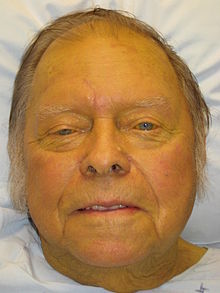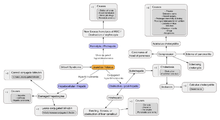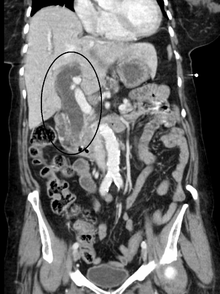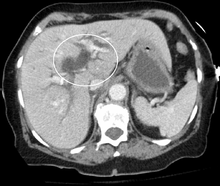- Jaundice
-
"Yellowing" redirects here. For the plant disease, see lethal yellowing. For paper degradation, see foxing."Icterus" and "icteric" redirect here. For the physiological event, see Ictal. For the songbird Icteria, see Yellow-breasted Chat.
Jaundice
Jaundice of the skin caused by hepatic failure.ICD-10 R17 ICD-9 782.4 DiseasesDB 7038 MedlinePlus 003243 MeSH D007565 Jaundice (also known as icterus;[1] attributive adjective: icteric) is a yellowish pigmentation of the skin, the conjunctival membranes over the sclerae (whites of the eyes), and other mucous membranes caused by hyperbilirubinemia (increased levels of bilirubin in the blood). This hyperbilirubinemia subsequently causes increased levels of bilirubin in the extracellular fluid. Concentration of bilirubin in blood plasma does not normally exceed 1 mg/dL (>17µmol/L). A concentration higher than 1.8 mg/dL (>30µmol/|L) leads to jaundice.[2] The term jaundice comes from the French word jaune, meaning yellow.
Jaundice is often seen in liver disease such as hepatitis or liver cancer. It may also indicate obstruction of the biliary tract, for example by gallstones or pancreatic cancer, or less commonly be congenital in origin.
Contents
Signs and symptoms
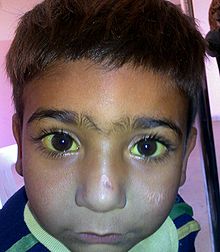 A 4-year-old boy with icteric (jaundiced) sclera which later proved to be a manifestation of hemolytic anemia due to G6PD deficiency following fava bean consumption.
A 4-year-old boy with icteric (jaundiced) sclera which later proved to be a manifestation of hemolytic anemia due to G6PD deficiency following fava bean consumption.
The conjunctiva of the eye are one of the first tissues to change color as bilirubin levels rise in jaundice. This is sometimes referred to as scleral icterus. However, the sclera themselves are not "icteric" (stained with bile pigment) but rather the conjunctival membranes that overlie them. The yellowing of the "white of the eye" is thus more properly termed conjunctival icterus.[3] The term "icterus" itself is sometimes incorrectly used to refer to jaundice that is noted in the sclera of the eyes, however its more common and more correct meaning is entirely synonymous with jaundice.[1][4]
It was once believed persons suffering from the medical condition jaundice saw everything as yellow. By extension, the jaundiced eye came to mean a prejudiced view, usually rather negative or critical. Alexander Pope, in "An Essay on Criticism" (1711), wrote: "All seems Infected that th' Infected spy, As all looks yellow to the Jaundic'd Eye."[5] Similarly in the mid-19th century the English poet Alfred Lord Tennyson wrote in the poem Locksley Hall: "So I triumphe'd ere my passion sweeping thro' me left me dry, left me with the palsied heart, and left me with a jaundiced eye."
Differential diagnosis
When a pathological process interferes with the normal functioning of the metabolism and excretion of bilirubin just described, jaundice may be the result. Jaundice is classified into three categories, depending on which part of the physiological mechanism the pathology affects. The three categories are:
Category Definition Pre-hepatic The pathology is occurring prior to the liver. Hepatic The pathology is located within the liver. Post-Hepatic The pathology is located after the conjugation of bilirubin in the liver. Pre-hepatic
Pre-hepatic jaundice is caused by anything which causes an increased rate of hemolysis (breakdown of red blood cells). In tropical countries, malaria can cause jaundice in this manner. Certain genetic diseases, such as sickle cell anemia, spherocytosis, thalassemia and glucose 6-phosphate dehydrogenase deficiency can lead to increased red cell lysis and therefore hemolytic jaundice. Commonly, diseases of the kidney, such as hemolytic uremic syndrome, can also lead to coloration. Defects in bilirubin metabolism also present as jaundice, as in Gilbert's syndrome (a genetic disorder of bilirubin metabolism which can result in mild jaundice, which is found in about 5% of the population)and Crigler-Najjar syndrome.
In jaundice secondary to hemolysis, the increased production of bilirubin, leads to the increased production of urine-urobilinogen. Bilirubin is not usually found in the urine because unconjugated bilirubin is not water-soluble, so, the combination of increased urine-urobilinogen with no bilirubin (since, unconjugated) in urine is suggestive of hemolytic jaundice.
Laboratory findings include:
- Urine: no bilirubin present, urobilinogen > 2 units (i.e., hemolytic anemia causes increased heme metabolism; exception: infants where gut flora has not developed).
- Serum: increased unconjugated bilirubin.
- Kernicterus is associated with increased unconjugated bilirubin.
Hepatocellular
Hepatocellular (hepatic) jaundice can be caused by acute hepatitis, hepatotoxicity, and alcoholic liver disease. Cell necrosis reduces the liver's ability to metabolize and excrete bilirubin leading to a buildup of unconjugated bilirubin in the blood. Other causes include primary biliary cirrhosis leading to an increase in plasma conjugated bilirubin because there is impairment of excretion of conjugated bilirubin into the bile. The blood contains abnormally raised amount of conjugated bilirubin and bile salts which are excreted in the urine. Jaundice seen in the newborn, known as neonatal jaundice, is common, occurring in almost every newborn[citation needed] as hepatic machinery for the conjugation and excretion of bilirubin does not fully mature until approximately two weeks of age. Rat fever (leptospirosis) can also cause hepatic jaundice. In hepatic jaundice, there is invariably cholestasis.
Laboratory findings depend on the cause of jaundice.
- Urine: Conjugated bilirubin present, urobilirubin > 2 units but variable (except in children). Kernicterus is a condition not associated with increased conjugated bilirubin.
- Plasma protein show characteristic changes.
- Plasma albumin level is low but plasma globulins are raised due to an increased formation of antibodies.
Post-hepatic
Post-hepatic jaundice, also called obstructive jaundice, is caused by an interruption to the drainage of bile in the biliary system. The most common causes are gallstones in the common bile duct, and pancreatic cancer in the head of the pancreas. Also, a group of parasites known as "liver flukes" can live in the common bile duct, causing obstructive jaundice. Other causes include strictures of the common bile duct, biliary atresia, ductal carcinoma, pancreatitis and pancreatic pseudocysts. A rare cause of obstructive jaundice is Mirizzi's syndrome.
In complete obstruction of the bile duct, no urobilinogen is found in the urine, since bilirubin has no access to the intestine and it is in the intestine that bilirubin gets converted to urobilinogen to be later released into the general circulation. In this case, presence of bilirubin (conjugated) in the urine without urine-urobilinogen suggests obstructive jaundice, either intra-hepatic or post-hepatic.
The presence of pale stools and dark urine suggests an obstructive or post-hepatic cause as normal feces get their color from bile pigments. However, although pale stools and dark urine are a feature of biliary obstruction, they can occur in many intra-hepatic illnesses and are therefore not a reliable clinical feature to distinguish obstruction from hepatic causes of jaundice.[6]
Patients also can present with elevated serum cholesterol, and often complain of severe itching or "pruritus" because of the deposition of bile salts.
No single test can differentiate between various classifications of jaundice. A combination of liver function tests is essential to arrive at a diagnosis.
Table of diagnostic tests[7] Function test Pre-hepatic Jaundice Hepatic Jaundice Post-hepatic Jaundice Total bilirubin Normal / Increased Increased Conjugated bilirubin Normal Increased Increased Unconjugated bilirubin Normal / Increased Increased Normal Urobilinogen Normal / Increased Increased Decreased / Negative Urine Color Normal Dark (urobilinogen + conjugated bilirubin) Dark (conjugated bilirubin) Stool Color Normal Pale Alkaline phosphatase levels Normal Increased Alanine transferase and Aspartate transferase levels Increased Conjugated Bilirubin in Urine Not Present Present Neonatal jaundice
Neonatal jaundice is usually harmless: this condition is often seen in infants around the second day after birth, lasting until day 8 in normal births, or to around day 14 in premature births. Serum bilirubin normally drops to a low level without any intervention required: the jaundice is presumably a consequence of metabolic and physiological adjustments after birth. In extreme cases, a brain-damaging condition known as kernicterus can occur, leading to significant lifelong disability; there are concerns that this condition has been rising in recent years due to inadequate detection and treatment of neonatal hyperbilirubinemia. A Bili light is often the tool used for early treatment, which often consists of exposing the baby to intensive phototherapy. Bilirubin count is lowered through bowel movements and urination so regular and proper feedings are especially important.[8]
Pathophysiology
In order to understand how jaundice results, the pathological processes that cause jaundice to take their effect must be understood. Jaundice itself is not a disease, but rather a sign of one of many possible underlying pathological processes that occur at some point along the normal physiological pathway of the metabolism of bilirubin.
When red blood cells have completed their life span of approximately 120 days, or when they are damaged, their membranes become fragile and prone to rupture. As each red blood cell traverses through the reticuloendothelial system, its cell membrane ruptures when its membrane is fragile enough to allow this. Cellular contents, including hemoglobin, are subsequently released into the blood. The hemoglobin is phagocytosed by macrophages, and split into its heme and globin portions. The globin portion, a protein, is degraded into amino acids and plays no role in jaundice. Two reactions then take place with the heme molecule. The first oxidation reaction is catalyzed by the microsomal enzyme heme oxygenase and results in biliverdin (green color pigment), iron and carbon monoxide. The next step is the reduction of biliverdin to a yellow color tetrapyrol pigment called bilirubin by cytosolic enzyme biliverdin reductase. This bilirubin is "unconjugated," "free" or "indirect" bilirubin. Approximately 4 mg of bilirubin per kg of blood is produced each day.[9] The majority of this bilirubin comes from the breakdown of heme from expired red blood cells in the process just described. However approximately 20 percent comes from other heme sources, including ineffective erythropoiesis, and the breakdown of other heme-containing proteins, such as muscle myoglobin and cytochromes.[9]
Hepatic events
The unconjugated bilirubin then travels to the liver through the bloodstream. Because this bilirubin is not soluble, however, it is transported through the blood bound to serum albumin. Once it arrives at the liver, it is conjugated with glucuronic acid (to form bilirubin diglucuronide, or just "conjugated bilirubin") to become more water soluble. The reaction is catalyzed by the enzyme UDP-glucuronyl transferase.
This conjugated bilirubin is excreted from the liver into the biliary and cystic ducts as part of bile. Intestinal bacteria convert the bilirubin into urobilinogen. From here the urobilinogen can take two pathways. It can either be further converted into stercobilinogen, which is then oxidized to stercobilin and passed out in the feces, or it can be reabsorbed by the intestinal cells, transported in the blood to the kidneys, and passed out in the urine as the oxidised product urobilin. Stercobilin and urobilin are the products responsible for the coloration of feces and urine, respectively.
Diagnostic approach
Most patients presenting with jaundice will have various predictable patterns of liver panel abnormalities, though significant variation does exist. The typical liver panel will include blood levels of enzymes found primarily from the liver, such as the aminotransferases (ALT, AST), and alkaline phosphatase (ALP); bilirubin (which causes the jaundice); and protein levels, specifically, total protein and albumin. Other primary lab tests for liver function include GGT and prothrombin time (PT).
Some bone and heart disorders can lead to an increase in ALP and the aminotransferases, so the first step in differentiating these from liver problems is to compare the levels of GGT, which will only be elevated in liver-specific conditions. The second step is distinguishing from biliary (cholestatic) or liver (hepatic) causes of jaundice and altered lab results. The former typically indicates a surgical response, while the latter typically leans toward a medical response. ALP and GGT levels will typically rise with one pattern while AST and ALT rise in a separate pattern. If the ALP (10–45 IU/L) and GGT (18–85) levels rise proportionately about as high as the AST (12–38 IU/L) and ALT (10–45 IU/L) levels, this indicates a cholestatic problem. On the other hand, if the AST and ALT rise is significantly higher than the ALP and GGT rise, this indicates an hepatic problem. Finally, distinguishing between hepatic causes of jaundice, comparing levels of AST and ALT can prove useful. AST levels will typically be higher than ALT. This remains the case in most hepatic disorders except for hepatitis (viral or hepatotoxic). Alcoholic liver damage may see fairly normal ALT levels, with AST 10x higher than ALT. On the other hand, if ALT is higher than AST, this is indicative of hepatitis. Levels of ALT and AST are not well correlated to the extent of liver damage, although rapid drops in these levels from very high levels can indicate severe necrosis. Low levels of albumin tend to indicate a chronic condition, while it is normal in hepatitis and cholestasis.
Lab results for liver panels are frequently compared by the magnitude of their differences, not the pure number, as well as by their ratios. The AST:ALT ratio can be a good indicator of whether the disorder is alcoholic liver damage (10), some other form of liver damage (above 1), or hepatitis (less than 1). Bilirubin levels greater than 10x normal could indicate neoplastic or intrahepatic cholestasis. Levels lower than this tend to indicate hepatocellular causes. AST levels greater than 15x tends to indicate acute hepatocellular damage. Less than this tend to indicate obstructive causes. ALP levels greater than 5x normal tend to indicate obstruction, while levels greater than 10x normal can indicate drug (toxic) induced cholestatic hepatitis or Cytomegalovirus. Both of these conditions can also have ALT and AST greater than 20× normal. GGT levels greater than 10x normal typically indicate cholestasis. Levels 5–10× tend to indicate viral hepatitis. Levels less than 5× normal tend to indicate drug toxicity. Acute hepatitis will typically have ALT and AST levels rising 20–30× normal (above 1000), and may remain significantly elevated for several weeks. Acetaminophen toxicity can result in ALT and AST levels greater than 50x normal.
Complications
Complications of jaundice include sepsis especially cholangitis, biliary cirrhosis, pancreatitis, coagulopathy, renal and liver failure. Other complications are related to the underlying disease and the procedures employed in the diagnosis and management of individual diseases. Cholangitis especially the suppurative type (Charcot’s triad or Raynaud’s pentad) is usually secondary to choledocholithiasis. It may also complicate procedures like ERCP. Treatment should include correction of coagulopathy, fluid/electrolyte anomaly, antibiotics and biliary drainage with ERCP where available or trans-hepatic drainage or surgery.
References
- ^ a b http://www.medterms.com/script/main/art.asp?articlekey=3890
- ^ Silbernagl S, Despopoulos A (2009). Color atlas of physiology (6 ed.). Thieme. p. 252. ISBN 9783135450063.
- ^ Findarticles.com, accessed Nov. 22, 2008
- ^ http://dictionary.reference.com/browse/icterus
- ^ From The Dictionary of Cliches by James Rogers (Ballantine Books, New York, 1985).
- ^ Beckingham, IJ; Ryder, SD (2001). "Investigation of liver and biliary disease". BMJ (Clinical research ed.) 322 (7277): 33–6. PMC 1119305. PMID 11141153. http://www.pubmedcentral.nih.gov/articlerender.fcgi?tool=pmcentrez&artid=1119305.
- ^ Goljan, Edward F., Rapid Review Pathology 2nd edition. Pg. 368–369. 2007.
- ^ O'Keefe, Lori (2001-05-05). "Increased vigilance needed to prevent kernicterus in newborns". American Academy of Pediatrics 18 (5): 231. http://aapnews.aappublications.org/cgi/content/full/18/5/231. Retrieved 2007-06-27.
- ^ a b Pashankar, D; Schreiber, RA (July 2001). "Jaundice in older children and adolescents". Pediatrics in Review 22 (7): 219–226. doi:10.1542/pir.22-7-219. PMID 11435623.
External links
Infants
- Children's Liver Disease Foundation
- National Niemann Pick Disease Foundation: jaundice at birth, enlarged spleen and/or enlarged liver
- Jaundice_in_newborn.jpg
Symptoms and signs: digestive system and abdomen (R10–R19, 787,789) GI tract Upper GI tractAccessory Abdominopelvic Abdominal – general Categories:- Symptoms and signs: Digestive system and abdomen
Wikimedia Foundation. 2010.

